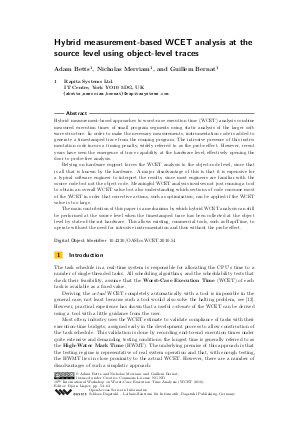Hybrid measurement-based WCET analysis at the source level using object-level traces
Authors Adam Betts, Nicholas Merriam, Guillem Bernat
-
Part of:
Volume:
10th International Workshop on Worst-Case Execution Time Analysis (WCET 2010)
Part of: Series: Open Access Series in Informatics (OASIcs)
Part of: Conference: Workshop on Worst-Case Execution Time Analysis (WCET) - License:
 Creative Commons Attribution-NonCommercial-NoDerivs 3.0 Unported license
Creative Commons Attribution-NonCommercial-NoDerivs 3.0 Unported license
- Publication Date: 2010-11-26
File

PDF
OASIcs.WCET.2010.54.pdf
- Filesize: 0.48 MB
- 10 pages
Document Identifiers
Subject Classification
Keywords
- WCET analysis
- hybrid analysis
- trace
Metrics
- Access Statistics
-
Total Accesses (updated on a weekly basis)
0Document
0Metadata
Abstract
Hybrid measurement-based approaches to worst-case execution time (WCET) analysis combine measured execution times of small program segments using static analysis of the larger software structure. In order to make the necessary measurements, instrumentation code is added to generate a timestamped trace from the running program. The intrusive presence of this instrumentation code incurs a timing penalty, widely referred to as the probe effect. However, recent years have seen the emergence of trace capability at the hardware level, effectively opening the door to probe-free analysis.
Relying on hardware support forces the WCET analysis to the object-code level, since that is all that is known by the hardware. A major disadvantage of this is that it is expensive for a typical software engineer to interpret the results, since most engineers are familiar with the source code but not the object code. Meaningful WCET analysis involves not just running a tool to obtain an overall WCET value but also understanding which sections of code consume most of the WCET in order that corrective actions, such as optimisation, can be applied if the WCET value is too large.
The main contribution of this paper is a mechanism by which hybrid WCET analysis can still be performed at the source level when the timestamped trace has been collected at the object level by state-of-the-art hardware. This allows existing, commercial tools, such as \rapitime{}, to operate without the need for intrusive instrumentation and thus without the probe effect.
Cite As Get BibTex
Adam Betts, Nicholas Merriam, and Guillem Bernat. Hybrid measurement-based WCET analysis at the source level using object-level traces. In 10th International Workshop on Worst-Case Execution Time Analysis (WCET 2010). Open Access Series in Informatics (OASIcs), Volume 15, pp. 54-63, Schloss Dagstuhl – Leibniz-Zentrum für Informatik (2010)
https://doi.org/10.4230/OASIcs.WCET.2010.54
BibTex
@InProceedings{betts_et_al:OASIcs.WCET.2010.54,
author = {Betts, Adam and Merriam, Nicholas and Bernat, Guillem},
title = {{Hybrid measurement-based WCET analysis at the source level using object-level traces}},
booktitle = {10th International Workshop on Worst-Case Execution Time Analysis (WCET 2010)},
pages = {54--63},
series = {Open Access Series in Informatics (OASIcs)},
ISBN = {978-3-939897-21-7},
ISSN = {2190-6807},
year = {2010},
volume = {15},
editor = {Lisper, Bj\"{o}rn},
publisher = {Schloss Dagstuhl -- Leibniz-Zentrum f{\"u}r Informatik},
address = {Dagstuhl, Germany},
URL = {https://drops.dagstuhl.de/entities/document/10.4230/OASIcs.WCET.2010.54},
URN = {urn:nbn:de:0030-drops-28255},
doi = {10.4230/OASIcs.WCET.2010.54},
annote = {Keywords: WCET analysis, hybrid analysis, trace}
}
